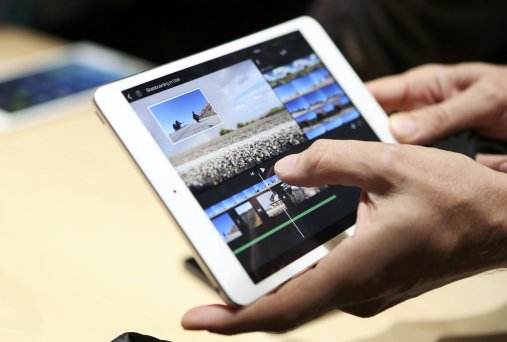Apple isn't the only company to make big announcements this week. Microsoft, refusing to surrender to the iPad, introduced its new Surface 2 and Surface 2 Pro, and Nokia, soon to be under Microsoft, made some noise with the Lumia 2520. Here's a roundup of the newest tablets headed to the market:
As expected, the new 9.7-inch iPad is thinner and lighter than earlier models, and comes in space gray and silver (what, no gold?). Although it doesn't boast the champagne hue of the iPhone 5s, it does sport the same A7 processing chip and M7 coprocessor. Also missing is the fingerprint sensor rumored to be included with the new iPad. It starts at $499 for a 16GB, Wi-Fi only model. Interestingly, Apple is keeping the iPad 2 around, selling that for $399. It will be available Nov. 1.
FIRST TAKE: iPad Air steals show with familiar feel
Apple's iPad Mini with Retina display
Apple's smaller tablet gets a big screen boost with the addition of a Retina display. The 7.9-inch device features 2048 x 1536 resolution and the A7 chip, along with 10 hours of battery life. It starts at $399 and will be available later in November, with the original iPad Mini to be available at $299.
Nokia's Lumia 2520
Nokia's connected Windows tablet — it is LTE-capable along with Wi-Fi — is called the Lumia 2520. It sports a 10.1-inch HD display, a 6.7 megapixel camera, and Zeiss optics that Nokia says is a first for a tablet, promising excellent pictures even when shot in low light. Nokia claims the 2520 can reach an 80% charge in one hour and says its integrated HERE Maps app makes the 2520 the only tablet with true offline maps. U.S. availability comes later in the year on AT&T, at an expected price of $499. Verizon also has confirmed it will be carrying the 2520 this quarter.
Microsoft Surface 2
Surface 2 runs Windows RT 8.1 and ranges from $449 to $549. The latest hardware sports amped up processing power, longer battery life, improved cameras, and a step up in screen quality to a 10.6-inch Full HD 1080p multi-touch display. Surface 2 also gets a single USB 3.0 port — it was a 2.0 port last time. At 1.5 pounds, it's a shade thinner and lighter than its predecessor. The biggest cosmetic change is that Surface 2 now comes in an Apple-like magnesium silver color compared to the dark titanium hue of the original.
Microsoft Surface Pro 2
The 2-pound Pro 2, pretty heavy and bulky for a tablet, weighs the same and is practically a dead ringer for the first Pro. It runs Windows 8.1 Pro and fetches between $899 and $1,799. If you're going to splurge on the pricier Pro model, which can handle older software but doesn't deliver as long a battery, you're not only comparing Surface Pro to other tablets, but to a wide range of excellent laptops, a comparison Surface Pro is not always going to win.




















